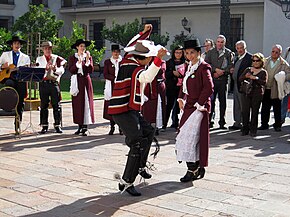This article needs additional citations for verification. (September 2017) |
You can help expand this article with text translated from the corresponding article in Spanish. (December 2019) Click [show] for important translation instructions.
|
| Fiestas Patrias | |
|---|---|
 People dancing cueca in the Palace of La Moneda | |
| Also called | El Dieciocho (en: The Eighteenth) |
| Observed by | Chilean people and residents on its territory. |
| Type | National |
| Significance | Date of the First National Meeting of Government in 1810. |
| Date | 18 September |
| Frequency | Annual |


The Fiestas Patrias (literally Homeland Holidays)[1] of Chile consist of two days, with a third one added on some years:
- 18 September, in commemoration of the proclamation of the First Governing Body of 1810, and marking the beginning of the Chilean Independence process.
- 19 September, known as the "Day of the Glories of the Army".
- Since 2007,[2] 17 September (if it should be a Monday) or 20 September (if it should be a Friday) will be included as well.
- Since 2017,[3] 17 September (if it should be a Friday) will also be included.
Within Chile the Fiestas Patrias are often referred to as the Dieciocho, or "18th" because the celebration occurs on 18 September. Unofficially, the celebration can last for around a week, depending on when it falls. For example, if the 18th is a Wednesday, public holidays are from Wednesday the 18th to Friday the 20th and celebrations begin the afternoon of Tuesday the 17th and continue until Sunday the 22nd. It is held close to the spring equinox of the Southern Hemisphere so it doubles as a spring festival. Chile's Declaration of Independence happened on 12 February. Most schools and jobs declare a week-long vacation for the holiday. This day is very important to the Chilean people because they are celebrating their freedom from Spanish rule.
- ^ Collins Spanish to English Dictionary, patrio.
- ^ "Días Feriados en Chile" (in Spanish). 19 October 2008. Retrieved 25 August 2018.
- ^ "Días Feriados en Chile" (in Spanish). 19 October 2008. Retrieved 23 January 2021.